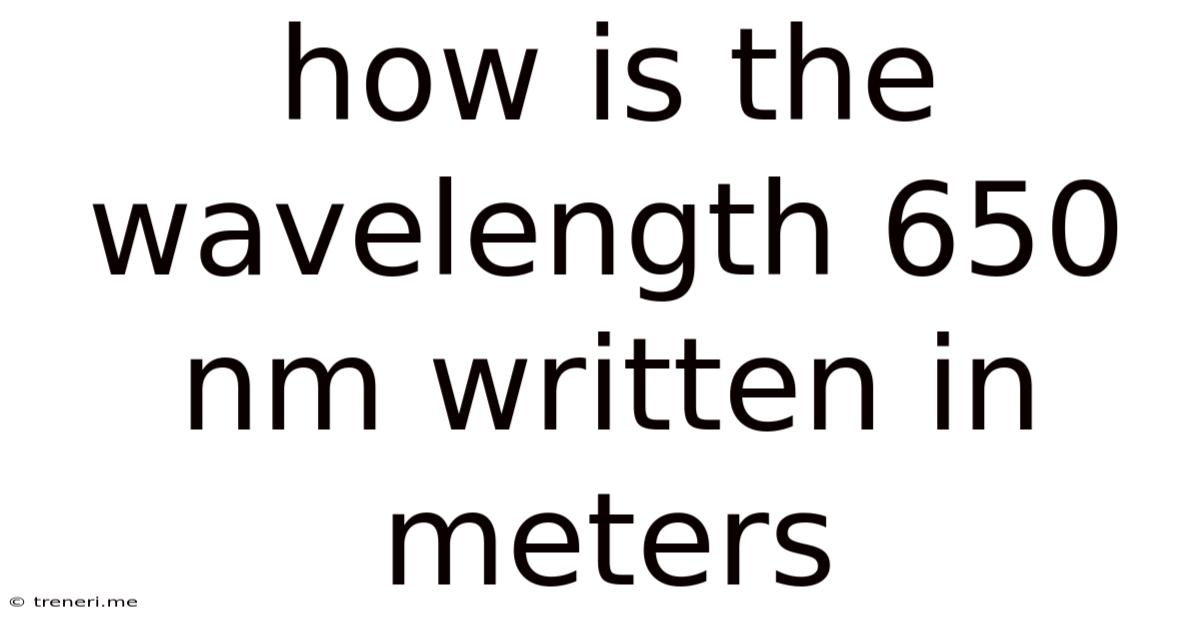How Is The Wavelength 650 Nm Written In Meters
Treneri
May 13, 2025 · 4 min read

Table of Contents
How is the Wavelength 650 nm Written in Meters? A Deep Dive into Unit Conversions and Scientific Notation
The question of how to convert 650 nanometers (nm) to meters (m) might seem trivial at first glance. However, it touches upon fundamental concepts in physics, particularly the understanding of units and scientific notation – skills crucial for anyone working with scientific data. This article will not only answer the question directly but also explore the broader context of unit conversion and the importance of scientific notation in representing very small or very large numbers.
Understanding Units of Measurement: The Metric System
Before diving into the conversion, let's establish a firm grasp of the metric system. The metric system, or International System of Units (SI), is a decimal system, meaning it's based on powers of 10. This makes conversions relatively straightforward. The fundamental unit of length in the SI system is the meter (m). Other units of length are derived from the meter using prefixes that denote powers of 10.
Key Prefixes and Their Equivalents
| Prefix | Symbol | Multiplier |
|---|---|---|
| kilo | k | 10<sup>3</sup> (1000) |
| hecto | h | 10<sup>2</sup> (100) |
| deca | da | 10<sup>1</sup> (10) |
| deci | d | 10<sup>-1</sup> (0.1) |
| centi | c | 10<sup>-2</sup> (0.01) |
| milli | m | 10<sup>-3</sup> (0.001) |
| micro | µ | 10<sup>-6</sup> (0.000001) |
| nano | n | 10<sup>-9</sup> (0.000000001) |
| pico | p | 10<sup>-12</sup> (0.000000000001) |
As you can see, the prefix "nano" (n) represents 10<sup>-9</sup>, meaning one billionth. Therefore, 1 nanometer is one billionth of a meter.
Converting 650 nm to Meters: The Calculation
Now, let's address the core question: How do we convert 650 nm to meters? Since 1 nm = 10<sup>-9</sup> m, the conversion is a simple multiplication:
650 nm * (10<sup>-9</sup> m/1 nm) = 6.5 x 10<sup>-7</sup> m
Therefore, 650 nm is equal to 6.5 x 10<sup>-7</sup> meters. This is expressed in scientific notation, a crucial aspect of representing very small (or very large) numbers concisely and accurately.
The Significance of Scientific Notation
Scientific notation is a standard way of writing very large or very small numbers. It's expressed in the form of a coefficient multiplied by 10 raised to a power. The coefficient is always a number between 1 and 10. For instance, in 6.5 x 10<sup>-7</sup>, 6.5 is the coefficient and -7 is the exponent.
Using scientific notation offers several advantages:
- Conciseness: It allows for compact representation of extremely large or small numbers, avoiding lengthy strings of zeros.
- Clarity: It enhances readability and makes it easier to grasp the magnitude of the number.
- Accuracy: It minimizes rounding errors during calculations, particularly essential in scientific computations.
Let's illustrate the difference between standard notation and scientific notation for the wavelength of 650 nm:
- Standard Notation: 0.00000065 meters (This is cumbersome and error-prone).
- Scientific Notation: 6.5 x 10<sup>-7</sup> meters (This is compact, clear, and precise).
Applications of 650 nm Wavelength: Red Light and Beyond
The wavelength of 650 nm falls within the visible light spectrum, specifically in the red region. This wavelength has numerous applications across various fields:
1. Laser Technology:
650 nm lasers are commonly used in:
- Laser pointers: These are readily available and used for presentations or indicating specific points.
- Optical storage: Certain DVD and Blu-ray technologies employ red lasers with wavelengths near 650 nm for data reading and writing.
- Medical applications: Red lasers find use in low-level laser therapy (LLLT) for pain management and wound healing, though the exact mechanisms are still under research.
2. Spectroscopy:
Spectroscopy is a crucial technique used to identify substances based on their interaction with light. 650 nm falls within the range used in many spectroscopic analyses, especially in studies involving biological samples and pigments.
3. Imaging and Microscopy:
Red light around 650 nm is often used in fluorescence microscopy to excite certain fluorophores, allowing for high-resolution visualization of cellular structures and processes.
4. Remote Sensing:
Satellite imagery and remote sensing technologies utilize specific wavelengths to analyze surface features. 650 nm could contribute to analyzing vegetation health and other surface characteristics.
Conclusion: Mastering Unit Conversions and Scientific Notation
Converting 650 nm to meters is a simple yet fundamental exercise that highlights the importance of unit conversion and scientific notation. Understanding these concepts is crucial for success in various scientific and technological fields. The conversion, resulting in 6.5 x 10<sup>-7</sup> meters, underscores the practical application of metric prefixes and the advantages of using scientific notation to express numbers concisely and accurately. Furthermore, the applications of this specific wavelength in diverse fields demonstrate its significant role in technology and scientific research. Remember to always utilize appropriate units and scientific notation to ensure accuracy and clarity in your work.
Latest Posts
Latest Posts
-
Cuantos Metros Es Una Hectarea De Terreno
May 13, 2025
-
What Percentage Of An Hour Is 50 Minutes
May 13, 2025
-
Greatest Common Factor Of 42 And 12
May 13, 2025
-
What Is 3 8 1 3 In Fraction Form
May 13, 2025
-
X 1 2 In Radical Form
May 13, 2025
Related Post
Thank you for visiting our website which covers about How Is The Wavelength 650 Nm Written In Meters . We hope the information provided has been useful to you. Feel free to contact us if you have any questions or need further assistance. See you next time and don't miss to bookmark.